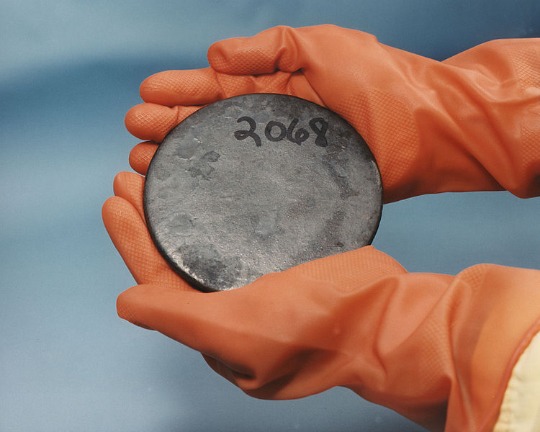Enriched uranium is back in the news with a report that Iran has begun creating the stuff at a heavily fortified site in the north of that country. But what is enriched uranium?
Uranium is element 92 on the periodic table–every molecule has 92 protons in its nucleus. The number of neutrons can vary, and that’s the difference between the three isotopes of uranium that we find here on Earth. Uranium-238 (92 protons plus 146 neutrons) is the most abundant form, and about 99.3 percent of all uranium is U-238. The rest is U-235 (0.7 percent), with a trace amount of U-234.
Uranium has a bad reputation (it is radioactive, after all), but U-238 has a very long half-life, meaning that it can be handled fairly safely as long as precautions are taken (as seen in the video below). More importantly here, though, U-238 isn’t fissile–it can’t start a nuclear reaction and sustain it.
U-235, however, is fissile; it can start a nuclear reaction and sustain it. But that 0.7 percent in naturally occurring uranium isn’t enough to make a bomb or even a nuclear reactor for a power plant. A power plant requires uranium with three to four percent U-235 (this is known as low-enriched or reactor-grade uranium), and a bomb needs uranium with a whopping 90 percent U-235 (highly enriched uranium).
Uranium enrichment, then, is the process by which a sample of uranium has its proportion of U-235 increased.
The first people to figure out how to do this were the scientists of the Manhattan Project during World War II. They came up with four methods to separate the U-235 from uranium ore: gaseous diffusion, electromagnetic separation, liquid thermal diffusion and centrifugation, though at the time they deemed centrifugation not practical for large-scale enrichment.
The most common methods for enriching uranium today are centrifugation (decades of development have made this method more efficient than it was during WWII) and gaseous diffusion. And other methods are being developed, including several based on laser techniques.
Highly enriched uranium, the type used in bombs, is expensive and difficult to create, which is why it remains a barrier, though not an insurmountable one, for countries wishing to develop nuclear weapons. And once a nation develops the capability for enriching uranium beyond reactor grade (Iran has reportedly begun to produce uranium enriched up to 20 percent), the path to weapons-grade uranium is significantly sped up.
Uranium is element 92 on the periodic table–every molecule has 92 protons in its nucleus. The number of neutrons can vary, and that’s the difference between the three isotopes of uranium that we find here on Earth. Uranium-238 (92 protons plus 146 neutrons) is the most abundant form, and about 99.3 percent of all uranium is U-238. The rest is U-235 (0.7 percent), with a trace amount of U-234.
Uranium has a bad reputation (it is radioactive, after all), but U-238 has a very long half-life, meaning that it can be handled fairly safely as long as precautions are taken (as seen in the video below). More importantly here, though, U-238 isn’t fissile–it can’t start a nuclear reaction and sustain it.
U-235, however, is fissile; it can start a nuclear reaction and sustain it. But that 0.7 percent in naturally occurring uranium isn’t enough to make a bomb or even a nuclear reactor for a power plant. A power plant requires uranium with three to four percent U-235 (this is known as low-enriched or reactor-grade uranium), and a bomb needs uranium with a whopping 90 percent U-235 (highly enriched uranium).
Uranium enrichment, then, is the process by which a sample of uranium has its proportion of U-235 increased.
The first people to figure out how to do this were the scientists of the Manhattan Project during World War II. They came up with four methods to separate the U-235 from uranium ore: gaseous diffusion, electromagnetic separation, liquid thermal diffusion and centrifugation, though at the time they deemed centrifugation not practical for large-scale enrichment.
The most common methods for enriching uranium today are centrifugation (decades of development have made this method more efficient than it was during WWII) and gaseous diffusion. And other methods are being developed, including several based on laser techniques.
Highly enriched uranium, the type used in bombs, is expensive and difficult to create, which is why it remains a barrier, though not an insurmountable one, for countries wishing to develop nuclear weapons. And once a nation develops the capability for enriching uranium beyond reactor grade (Iran has reportedly begun to produce uranium enriched up to 20 percent), the path to weapons-grade uranium is significantly sped up.

ليست هناك تعليقات:
إرسال تعليق